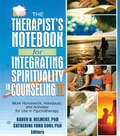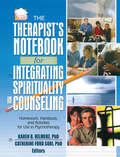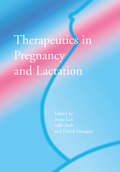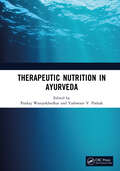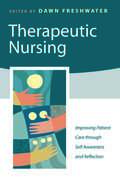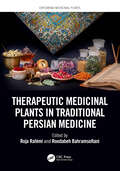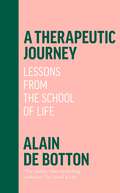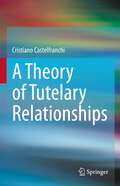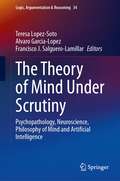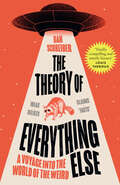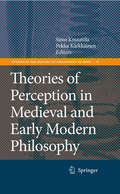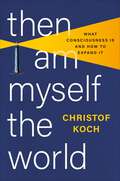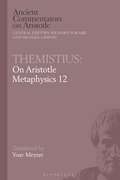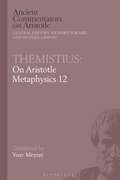- Table View
- List View
The Therapist's Notebook for Integrating Spirituality in Counseling II: More Homework, Handouts, and Activities for Use in Psychotherapy
by Karen B. Helmeke Catherine Ford SoriMore activities to tap into the strength of your clients’ spiritual beliefs to achieve therapeutic goals. The Therapist’s Notebook for Integrating Spirituality in Counseling II is the second volume of a comprehensive two-volume resource that provides practical interventions from respected experts from a wide range of backgrounds and theoretical perspectives. This volume includes several practical strategies and techniques to easily incorporate spirituality into psychotherapy. You’ll find in-session activities, homework assignments, and client and therapist handouts that utilize a variety of therapeutic models and techniques and address a broad range of topics and problems. The chapters of The Therapist’s Notebook for Integrating Spirituality in Counseling II are grouped into four sections: Models of Therapy Used in Integrating Spirituality; Integrating Spirituality with Age-Specific Populations: Children, Adolescents, and the Elderly; Integrating Spirituality with Specific Multicultural Populations; and Involving Spirituality when Dealing with Illness, Loss, and Trauma. As in Volume One, each clinician-friendly chapter also includes sections on resources where the counselor can learn more about the topic or technique used in the chapter—as well as suggested books, articles, chapters, videos, and Web sites to recommend to clients. Every chapter follows the same easy-to-follow format: objectives, rationale for use, instructions, brief vignette, suggestions for follow-up, contraindications, references, professional readings and resources, and bibliotherapy sources for the client. The Therapist’s Notebook for Integrating Spirituality in Counseling II adds more useful activities and homework counselors can use in their practice, such as: using religion or spirituality in solution-oriented brief therapy “Cast of Character” counseling using early memories to explore adolescent and adult spirituality cognitive behavioral treatment of obsessive-compulsive disorder age-specific clients such as children or the elderly multicultural populations and spirituality dealing with illness, loss, and trauma recovering from fetal loss creative art techniques with caregivers in group counseling and much more! The Therapist’s Notebook for Integrating Spirituality in Counseling II provides even more creative and helpful homework and activities that are perfect for pastoral counselors, clergy, social workers, marriage and family therapists, counselors, psychologists, Christian counselors, educators who teach professional issues, ethics, counseling, and multicultural issues, and students.
The Therapist's Notebook for Integrating Spirituality in Counseling II: More Homework, Handouts, and Activities for Use in Psychotherapy
by Karen B. Helmeke Catherine Ford SoriMore activities to tap into the strength of your clients’ spiritual beliefs to achieve therapeutic goals. The Therapist’s Notebook for Integrating Spirituality in Counseling II is the second volume of a comprehensive two-volume resource that provides practical interventions from respected experts from a wide range of backgrounds and theoretical perspectives. This volume includes several practical strategies and techniques to easily incorporate spirituality into psychotherapy. You’ll find in-session activities, homework assignments, and client and therapist handouts that utilize a variety of therapeutic models and techniques and address a broad range of topics and problems. The chapters of The Therapist’s Notebook for Integrating Spirituality in Counseling II are grouped into four sections: Models of Therapy Used in Integrating Spirituality; Integrating Spirituality with Age-Specific Populations: Children, Adolescents, and the Elderly; Integrating Spirituality with Specific Multicultural Populations; and Involving Spirituality when Dealing with Illness, Loss, and Trauma. As in Volume One, each clinician-friendly chapter also includes sections on resources where the counselor can learn more about the topic or technique used in the chapter—as well as suggested books, articles, chapters, videos, and Web sites to recommend to clients. Every chapter follows the same easy-to-follow format: objectives, rationale for use, instructions, brief vignette, suggestions for follow-up, contraindications, references, professional readings and resources, and bibliotherapy sources for the client. The Therapist’s Notebook for Integrating Spirituality in Counseling II adds more useful activities and homework counselors can use in their practice, such as: using religion or spirituality in solution-oriented brief therapy “Cast of Character” counseling using early memories to explore adolescent and adult spirituality cognitive behavioral treatment of obsessive-compulsive disorder age-specific clients such as children or the elderly multicultural populations and spirituality dealing with illness, loss, and trauma recovering from fetal loss creative art techniques with caregivers in group counseling and much more! The Therapist’s Notebook for Integrating Spirituality in Counseling II provides even more creative and helpful homework and activities that are perfect for pastoral counselors, clergy, social workers, marriage and family therapists, counselors, psychologists, Christian counselors, educators who teach professional issues, ethics, counseling, and multicultural issues, and students.
The Therapist's Notebook for Integrating Spirituality in Counseling I: Homework, Handouts, and Activities for Use in Psychotherapy
by Karen B. Helmeke Catherine Ford SoriLearn to initiate the integration of your clients’ spirituality as an effective practical intervention. A client’s spiritual and religious beliefs can be an effective springboard for productive therapy. How can a therapist sensitively prepare for the task? The Therapist’s Notebook for Integrating Spirituality in Counseling is the first volume of a comprehensive two-volume resource that provides practical interventions from a wide range of backgrounds and theoretical perspectives. This volume helps prepare clinicians to undertake and initiate the integration of spirituality in therapy with clients and provides easy-to-follow examples. The book provides a helpful starting point to address a broad range of topics and problems. The chapters of The Therapist’s Notebook for Integrating Spirituality in Counseling are grouped into five sections: Therapist Preparation and Professional Development; Assessment of Spirituality; Integrating Spirituality in Couples Therapy; Specific Techniques and/or Topics Used in Integrating Spirituality; and Use of Scripture, Prayer, and Other Spiritual Practices. Designed to be clinician-friendly, each chapter also includes sections on resources where counselors can learn more about the topic or technique used in the chapter—as well as suggested books, articles, chapters, videos, and Web sites to recommend to clients. Each chapter utilizes similar formatting to remain clear and easy-to-follow that includes objectives, rationale for use, instructions, brief vignette, suggestions for follow-up, contraindications, references, professional readings and resources, and bibliotherapy sources for the client. The first volume of The Therapist’s Notebook for Integrating Spirituality in Counseling helps set a solid foundation and provides comprehensive instruction on: ethically incorporating spirituality into the therapeutic setting professional disclosure building a spiritual referral source through local clergy assessment of spirituality the spirituality-focused genogram using spirituality in couples therapy helping couples face career transitions dealing with shame addiction recovery the use of scripture and prayer overcoming trauma in Christian clients and much more! The Therapist’s Notebook for Integrating Spirituality in Counseling is a stimulating, creative resource appropriate for any clinician or counselor, from novices to experienced mental health professionals. This first volume is perfect for pastoral counselors, clergy, social workers, marriage and family therapists, counselors, psychologists, Christian counselors, educators who teach professional issues, ethics, counseling, and multicultural issues, and students.
The Therapist's Notebook for Integrating Spirituality in Counseling I: Homework, Handouts, and Activities for Use in Psychotherapy
by Karen B. Helmeke Catherine Ford SoriLearn to initiate the integration of your clients’ spirituality as an effective practical intervention. A client’s spiritual and religious beliefs can be an effective springboard for productive therapy. How can a therapist sensitively prepare for the task? The Therapist’s Notebook for Integrating Spirituality in Counseling is the first volume of a comprehensive two-volume resource that provides practical interventions from a wide range of backgrounds and theoretical perspectives. This volume helps prepare clinicians to undertake and initiate the integration of spirituality in therapy with clients and provides easy-to-follow examples. The book provides a helpful starting point to address a broad range of topics and problems. The chapters of The Therapist’s Notebook for Integrating Spirituality in Counseling are grouped into five sections: Therapist Preparation and Professional Development; Assessment of Spirituality; Integrating Spirituality in Couples Therapy; Specific Techniques and/or Topics Used in Integrating Spirituality; and Use of Scripture, Prayer, and Other Spiritual Practices. Designed to be clinician-friendly, each chapter also includes sections on resources where counselors can learn more about the topic or technique used in the chapter—as well as suggested books, articles, chapters, videos, and Web sites to recommend to clients. Each chapter utilizes similar formatting to remain clear and easy-to-follow that includes objectives, rationale for use, instructions, brief vignette, suggestions for follow-up, contraindications, references, professional readings and resources, and bibliotherapy sources for the client. The first volume of The Therapist’s Notebook for Integrating Spirituality in Counseling helps set a solid foundation and provides comprehensive instruction on: ethically incorporating spirituality into the therapeutic setting professional disclosure building a spiritual referral source through local clergy assessment of spirituality the spirituality-focused genogram using spirituality in couples therapy helping couples face career transitions dealing with shame addiction recovery the use of scripture and prayer overcoming trauma in Christian clients and much more! The Therapist’s Notebook for Integrating Spirituality in Counseling is a stimulating, creative resource appropriate for any clinician or counselor, from novices to experienced mental health professionals. This first volume is perfect for pastoral counselors, clergy, social workers, marriage and family therapists, counselors, psychologists, Christian counselors, educators who teach professional issues, ethics, counseling, and multicultural issues, and students.
Therapeutics in Pregnancy and Lactation
by Anne Lee Sally Inch David FineganThis book will assist doctors, pharmacists, midwives and other health professionals in dealing with the issue of medicine use in pregnant and breastfeeding women. It gives practical guidance on the principles of safe and effective prescribing, summarises the known effects of widely used drugs, and provides up-to-date information in one accessible source. With an impressive list of contributors, Therapeutics in Pregnancy and Lactation offers clear guidelines and comprehensive advice on a diverse range of topics from drug abuse to hypertension and epilepsy.
Therapeutics in Pregnancy and Lactation
by Anne Lee Sally Inch David FineganThis book will assist doctors, pharmacists, midwives and other health professionals in dealing with the issue of medicine use in pregnant and breastfeeding women. It gives practical guidance on the principles of safe and effective prescribing, summarises the known effects of widely used drugs, and provides up-to-date information in one accessible source. With an impressive list of contributors, Therapeutics in Pregnancy and Lactation offers clear guidelines and comprehensive advice on a diverse range of topics from drug abuse to hypertension and epilepsy.
Therapeutic Nutrition in Ayurveda
by Pankaj Wanjarkhedkar Yashwant V. PathakNutrition remains the key to the successful treatment of diseases, in addition to the various evolved medical treatments across the world. The treatment outcome improves to a better extent with a degree of nourishment of the patients. Therapeutic Nutrition in Ayurveda (TNA) categorizes diseases system-wise and discusses nutrition with references from Ayurveda classics as well as publications from indexed journals in today’s world. This book emerges as a pilot project to discuss the clinical experiences directly and the concept of nutravigilance by experienced authors of respective specialties like hepatology, neurology, dermatology, ophthalmology, oncology, cardiology, gynecology, and so on. It broadly discusses diet and nutrition based on 12 different groups of diet in Ayurveda. Nutrition has been widely discussed for every disease dynamically in Ayurveda, with details of exclusion and inclusion of foods over a stipulated period or entire duration of treatment. Key Features: Presents system-wise and disease-wise therapeutic nutrition Includes clinical experience of physicians on therapeutic nutrition Contains interdisciplinary discussion on therapeutic nutrition with an integrated approach The integration of traditional and conventional health systems, along with the multidisciplinary approach, is the emerging trend for inclusive health care in the coming decades. This book serves as a handy guide for health care professionals across the continents, providing interdisciplinary correlations on nutrition.
Therapeutic Nutrition in Ayurveda
by Pankaj Wanjarkhedkar Yashwant V. PathakNutrition remains the key to the successful treatment of diseases, in addition to the various evolved medical treatments across the world. The treatment outcome improves to a better extent with a degree of nourishment of the patients. Therapeutic Nutrition in Ayurveda (TNA) categorizes diseases system-wise and discusses nutrition with references from Ayurveda classics as well as publications from indexed journals in today’s world. This book emerges as a pilot project to discuss the clinical experiences directly and the concept of nutravigilance by experienced authors of respective specialties like hepatology, neurology, dermatology, ophthalmology, oncology, cardiology, gynecology, and so on. It broadly discusses diet and nutrition based on 12 different groups of diet in Ayurveda. Nutrition has been widely discussed for every disease dynamically in Ayurveda, with details of exclusion and inclusion of foods over a stipulated period or entire duration of treatment. Key Features: Presents system-wise and disease-wise therapeutic nutrition Includes clinical experience of physicians on therapeutic nutrition Contains interdisciplinary discussion on therapeutic nutrition with an integrated approach The integration of traditional and conventional health systems, along with the multidisciplinary approach, is the emerging trend for inclusive health care in the coming decades. This book serves as a handy guide for health care professionals across the continents, providing interdisciplinary correlations on nutrition.
Therapeutic Nursing: Improving Patient Care through Self-Awareness and Reflection (PDF)
by Dawn FreshwaterGaining self-awareness is a vital aspect of professional development for all who work in the caring professions. In nursing especially, the ability to evaluate oneself affects all areas of practice, including direct patient care, working relationships with colleagues and maintaining one's own well-being in the often pressured environment of health care.
Therapeutic Medicinal Plants in Traditional Persian Medicine (Exploring Medicinal Plants)
by Roja Rahimi Roodabeh BahramsoltaniTraditional Persian Medicine (TPM) is one of the oldest medical doctrines, globally known due to pioneering physicians and scientists. The greatest source of natural medicines in TPM originates from medicinal plants. Therapeutic Medicinal Plants in Traditional Persian Medicine provides a background on the history of TPM, as well as an introduction to 40 of the most popular medicinal plants used in TPM. It is a practical guide for readers interested in medicinal plants used in the prevention, management, and treatment of different diseases.Features: Includes both traditional therapeutic applications and modern evidence/ uses Makes a comparison between preclinical and clinical studies Provides information on major chemical constituents, therapeutic uses, adverse reactions, and safety for each plant species A volume in the “Exploring Medicinal Plants” series, this book is a valuable resource for researchers, students, academicians, and scientists dealing witth medicinal plants, as well as for those interested in the fields of pharmacognosy, naturopathy, phytotherapy, and traditional medicines.
Therapeutic Medicinal Plants in Traditional Persian Medicine (Exploring Medicinal Plants)
Traditional Persian Medicine (TPM) is one of the oldest medical doctrines, globally known due to pioneering physicians and scientists. The greatest source of natural medicines in TPM originates from medicinal plants. Therapeutic Medicinal Plants in Traditional Persian Medicine provides a background on the history of TPM, as well as an introduction to 40 of the most popular medicinal plants used in TPM. It is a practical guide for readers interested in medicinal plants used in the prevention, management, and treatment of different diseases.Features: Includes both traditional therapeutic applications and modern evidence/ uses Makes a comparison between preclinical and clinical studies Provides information on major chemical constituents, therapeutic uses, adverse reactions, and safety for each plant species A volume in the “Exploring Medicinal Plants” series, this book is a valuable resource for researchers, students, academicians, and scientists dealing witth medicinal plants, as well as for those interested in the fields of pharmacognosy, naturopathy, phytotherapy, and traditional medicines.
Therapeutic Medicinal Plants: From Lab to the Market
by Marta C. T. Duarte Mahendra RaiMedicinal plants have been used in the prevention, diagnosis, and elimination of diseases based on the practical experience of thousands of years. There is a pressing need to initiate and transform laboratory research into fruitful formulations leading to the development of newer products for the cure of diseases such as AIDS, cancer, and hepatitis
A Therapeutic Journey: Lessons from the School of Life
by Alain de BottonThe essential guide to mental health from the bestselling author of The School of LifeThis is a book about getting unwell. About losing direction and hope. About imagining that we have let ourselves and everyone down.But it is also a book about getting better. About regaining the thread, rediscovering meaning and finding a way back to connection and joy.Here, Alain de Botton follows the arc of a mental health journey, from crisis to recuperation; the moments we realize we cannot cope; the acts of selfcare or therapy in which we find respite; and the days we finally reclaim a sense of stability. Written with understanding and kindness, it is both a source of companionship in our loneliest moments - whether it's a relationship breakdown, a career setback or anxiety around the everyday - and a practical guide that will help us find reasons for hope.We are all on our own journey towards recovery. This book is for anyone ready to understand theirs.'Alain de Botton is a brave and highly intelligent writer' Observer'One of our most consistently illuminating writers on contemporary culture' John Gray, New Statesman
Therapeutic and Nutritional Uses of Algae
by Leonel PereiraAlgae have been used since ancient times as food, fodder, fertilizer and as source of medicine. Nowadays seaweeds represent an unlimited source of the raw materials used in pharmaceutical, food industries, medicine and cosmetics. They are nutritionally valuable as fresh or dried vegetables, or as ingredients in a wide variety of prepared foods. In particular, seaweeds contain significant quantities of protein, lipids, minerals and vitamins. There is limited information about the role of algae and algal metabolites in medicine. Only a few taxa have been studied for their use in medicine. Many traditional cultures report curative powers from selected alga, in particular tropical and subtropical marine forms. This is especially true in the maritime areas of Asia, where the sea plays a significant role in daily activities. Nonetheless, at present, only a few genera and species of algae are involved in aspects of medicine and therapy. Beneficial uses of algae or algal products include those that may mimic specific manifestations of human diseases, production of antibiotic compounds, or improvement of human nutrition in obstetrics, dental research, thallassotherapy, and forensic medicine.
Therapeutic and Nutritional Uses of Algae
by Leonel PereiraAlgae have been used since ancient times as food, fodder, fertilizer and as source of medicine. Nowadays seaweeds represent an unlimited source of the raw materials used in pharmaceutical, food industries, medicine and cosmetics. They are nutritionally valuable as fresh or dried vegetables, or as ingredients in a wide variety of prepared foods. In particular, seaweeds contain significant quantities of protein, lipids, minerals and vitamins. There is limited information about the role of algae and algal metabolites in medicine. Only a few taxa have been studied for their use in medicine. Many traditional cultures report curative powers from selected alga, in particular tropical and subtropical marine forms. This is especially true in the maritime areas of Asia, where the sea plays a significant role in daily activities. Nonetheless, at present, only a few genera and species of algae are involved in aspects of medicine and therapy. Beneficial uses of algae or algal products include those that may mimic specific manifestations of human diseases, production of antibiotic compounds, or improvement of human nutrition in obstetrics, dental research, thallassotherapy, and forensic medicine.
Theosophy: An Introduction to the Supersensible Knowledge of the World and the Destination of Man (Barnes And Noble Digital Library)
by Rudolf SteinerGiven his energetic involvement in practical initiatives and extensive lecturing, Rudolf Steiner had little time to write books. Of those he did write - belonging almost entirely to the earlier years of his work - four titles form an indispensable introduction to his later teaching: Knowledge of the Higher Worlds, Occult Science, The Philosophy of Freedom and Theosophy. Theosophy focuses on a psychology based not on the usual duality of body and mind, but on the more ancient division of body, soul and spirit. Steiner describes in detail the functions and organs of these three aspects of the human being, and the objective realms to which they belong. Just as the body derives from and belongs to the material world, so do the human soul and spirit belong to their own specific realms. These are the dimensions through which all human beings travel in the life after death, and in which - after passing the 'midnight hour' - we prepare to seek our destiny, or karma, in a new life. Theosophy features one of the most comprehensive and condensed of all Steiner's accounts of these realms, and of the experiences which our immortal being undergoes in passing through them. The book ends with a chapter on the modern 'path of knowledge', in which Steiner describes the exercises through which every person may develop the latent powers of perception which are necessary for a knowledge of metaphysical worlds.
A Theory of Tutelary Relationships
by Cristiano CastelfranchiThe purpose of the book is to propose and exploit an analytical, critical, well defined theory of a very crucial human social relation that I call “Tutelarity/ Tutelage”. This will thus explain how/why such relation is so relevant at any layer of sociality: from affective relationships, to social cooperation and interactions, to politics and democracy. The approach is theoretical and strongly grounded on cognitive science and the models of human mind: beliefs, desires, expectations, emotions, etc. Written in an accessible way, it will be of interest for a large audience, specifically to researchers and scientists interested in cognitive science and the dynamics of social relationships alike.
The Theory of Mind Under Scrutiny: Psychopathology, Neuroscience, Philosophy of Mind and Artificial Intelligence (Logic, Argumentation & Reasoning #34)
by Teresa Lopez-Soto Alvaro Garcia-Lopez Francisco J. Salguero-LamillarThis book is a call to expand and diversify our approach to the study of the human mind in relation to the Theory of Mind. It proposes that it is necessary to combine cross-disciplinary methods to arrive at a more complete understanding of how our minds work. Seeking to expand the discussion surrounding the Theory of Mind beyond the field of psychology, and its focus on our capacity to ascribe mental states to other people, this volume collects evidence and research to point to a more holistic understanding of our own minds, the minds of others, behavior, language, and reasoning. This book therefore illuminates the conceptual intricacy underlying the Theory of Mind. It posits that a wide scope is necessary to make a breakthrough in scientific research towards a full understanding of the nature, function, and development of our capacity to converge on biological processes of the brain towards consciousness, emotion, awareness, and cognition. The volume presents methods, results, critiques, and models intended to provoke debates in various academic disciplines. It is of interest to scholars working in psychology, neuroscience, philosophy of mind, and artificial intelligence.
The Theory of Everything Else
by Dan SchreiberThis is not a book of facts; it’s a book of ‘facts’. Should you finish it believing we became the planet’s dominant species because predators found us too smelly to eat; or that the living bloodline of Christ is a family of Japanese garlic farmers – well, that’s on you. Why are we here? Do ghosts exist? Did life on Earth begin after a badly tidied-up picnic? Was it just an iceberg that sank the Titanic? Are authors stealing their plotlines from the future? Will we ever talk to animals? And why, when you’re in the shower, does the shower curtain always billow in towards you? We don’t know the answers to any of these questions. But don’t worry, no matter what questions you have, you can bet on the fact that there is someone (or something) out there, investigating it on your behalf. From the sports stars who use cosmic energy to office plants investigating murders, The Theory of Everything Else will act as a handbook for those who want to think differently.
A Theory of Epistemic Justification (Philosophical Studies Series #112)
by J. LeplinOne goal of epistemology is to refute the skeptic. Another, with an equally dist- guished if briefer pedigree, is to make sense of science as a knowledge-acquiring enterprise. The goals are incompatible, in that the latter presupposes that the skeptic is wrong. The incompatibility is not strict. One could have both goals, conditi- ing the latter upon success at the former. In fact, however, epistemologies aimed at the skeptic tend not to get anywhere near science. They’ve got all they can handle guring out how we can know we have hands. I come to epistemology from the philosophy of science, my original interest in which was epistemological. Philosophers of science are concerned with epistemic justi cation, but their question about it is how far it extends. They take justi cation to be unproblematic at the level of ordinary experience; their worries begin with the interpretation of experience as evidence for theory. They are interested in the scope of scienti c knowledge. Having taken a position on this question (1997), - guing that justi cation extends to theoretical hypotheses, I came to wonder about the nature of justi cation generally. This is not a belated discovery of the skeptical problem or a reconsideration of what I took to be unproblematic. It is simply an interest in the possibility of locating epistemic advance in science within a broader understanding of the nature of epistemic justi cation. Now that I know that just- cation extends to theory, I am taking a step back and asking what justi cation is.
Theories of Perception in Medieval and Early Modern Philosophy (Studies in the History of Philosophy of Mind #6)
by Simo Knuuttila Pekka KärkkäinenThis is the first extensive account of philosophical psychology of perception from ancient to early modern times. The book aims to shed light on the developments in the theories of sense-perception in medieval Arabic and Latin philosophy, their ancient background and traditional and new themes in early modern thought. Particular attention is paid to the philosophically significant parts of the theories. The articles concentrate on the so-called external senses and related themes.
Then I Am Myself the World: What Consciousness Is and How to Expand It
by Christof Koch"Deeply personal and infinitely digestible, Then I Am Myself the World is a remarkable must-read for anyone interested in knowing their mind.&”―Judson Brewer MD, PhD, New York Times–bestselling author of Unwinding Anxiety The world&’s leading investigator of consciousness argues that by understanding what consciousness does—cause change in the world—we can understand its origins and its future In Then I Am Myself the World, Christof Koch explores the only thing we directly experience: consciousness. At the book&’s heart is integrated-information theory, the idea that the essence of consciousness is the ability to exert causal power over itself, to be an agent of change. Koch investigates the physical origins of consciousness in the brain and how this knowledge can be used to measure consciousness in natural and artificial systems. Enabled by such tools, Koch reveals when and where consciousness exists, and uses that knowledge to confront major social and scientific questions: When does a fetus first become self-aware? Can psychedelic and mystical experiences transform lives? What happens to consciousness in near-death experiences? Why will generative AI ultimately be able to do the very thing we can do, yet never feel any of it? And do our experiences reveal a single, objective reality? This is an essential book for anyone who seeks to understand ourselves and the future we are creating.
Themistius: On Aristotle Metaphysics 12 (Ancient Commentators on Aristotle)
by Yoav MeyravThis is the only commentary on Aristotle's theological work, Metaphysics, Book 12, to survive from the first six centuries CE – the heyday of ancient Greek commentary on Aristotle. Though the Greek text itself is lost, a full English translation is presented here for the first time, based on Arabic versions of the Greek and a Hebrew version of the Arabic. In his commentary Themistius offers an extensive re-working of Aristotle, confirming that the first principle of the universe is indeed Aristotle's God as intellect, not the intelligibles thought by God. The identity of intellect with intelligibles had been omitted by Aristotle in Metaphysics 12, but is suggested in his Physics 3.3 and On the Soul 3, and later by Plotinus. Laid out here in an accessible translation and accompanied by extensive commentary notes, introduction and indexes, the work will be of interest for students and scholars of Neoplatonist philosophy, ancient metaphysics, and textual transmission.
Themistius: On Aristotle Metaphysics 12 (Ancient Commentators on Aristotle)
This is the only commentary on Aristotle's theological work, Metaphysics, Book 12, to survive from the first six centuries CE – the heyday of ancient Greek commentary on Aristotle. Though the Greek text itself is lost, a full English translation is presented here for the first time, based on Arabic versions of the Greek and a Hebrew version of the Arabic. In his commentary Themistius offers an extensive re-working of Aristotle, confirming that the first principle of the universe is indeed Aristotle's God as intellect, not the intelligibles thought by God. The identity of intellect with intelligibles had been omitted by Aristotle in Metaphysics 12, but is suggested in his Physics 3.3 and On the Soul 3, and later by Plotinus. Laid out here in an accessible translation and accompanied by extensive commentary notes, introduction and indexes, the work will be of interest for students and scholars of Neoplatonist philosophy, ancient metaphysics, and textual transmission.
Theming Skills for Yoga Teachers: Tools to Inspire Creative and Connected Classes (Yoga Teaching Guides)
by Tanja MickwitzConsidering yoga philosophy, mythology, poses, and nature, Theming Skills for Yoga Teachers provides guidance in how to skilfully theme yoga classes with greater depth and give students meaningful ways to integrate yoga into their lives beyond the mat. The book encourages autonomy of interpretation whilst also providing questions and exercises at the end of each chapter to help inspire ideas and form a synergy of practical application and creativity. Essential for both yoga teachers and trainees, this book allows them to create more meaningful yoga sessions and hone their teaching ability to provide a more memorable and holistic learning experience.
